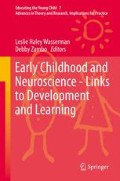Abstract
This chapter initially discusses the debate regarding the brain information, classroom practices, and subsequent commerce that has been created to serve the educational market.
The chapter reviews the basics of brain structures and functions and is designed to provide readers with effective ways to share information with both preservice and in-service teachers. Further, the chapter reviews how this information influences classroom practices through principles of learning.
Access this chapter
Tax calculation will be finalised at checkout
Purchases are for personal use only
References
Brandt, R. (1999). Educators need to know about the human brain. Phi Delta Kappan, 81(3), 235.
Center on the Developing Child at Harvard University. (2011). Building the brain’s “air traffic control” system: How early experiences shape the development of executive function (Working Paper No. 11). Retrieved from www.developingchild.harvard.edu
Cialdini, R. B. (2001). Influence: Science and practice (4th ed.). Boston: Allyn & Bacon.
Dubinsky, J. M. (2010). Neuroscience education for prekindergarten – 12 teachers. Journal of Neuroscience, 30(24), 8057–8060. doi:10.1523/JNEUROSCI.2322-10.2010.
Dwyer, D. S. (2002). Glucose metabolism in the brain. International Review of Neurobiology, 51. New York: Academic Press.
Enz, B. J., Bergeron, B., & Wolfe, M. (2007). Learning to teach. Dubuque, IA: Kendall-Hunt Publishers.
Geake, J., & Cooper, P. (2003). Cognitive neuroscience: Implications for education? Westminster Studies in Education, 26(1), 7–20. doi:10.1080/0140672030260102.
Goldberg, E. (2001). The executive brain: Frontal lobes and the civilized mind. New York: Oxford University Press.
Goldberg, E. (2009). The new executive brain: Frontal lobes in a complex world. New York: Oxford University Press.
Hall, J. (2005). Neuroscience and education: A review of the contribution of brain science to teaching and learning. Scottish Council for Research in Education. University of Glasgow.
Hirsh-Pasek, K., & Bruer, J. T. (2007). The brain/education barrier. Science, 317(5843), 1293.
Hutchinson, S., Lee, L. H., Gaab, N., & Schlaug, G. (2003). Cerebellar volume of musicians. Cerebral Cortex, 13(9), 943–949.
Illes, J., Moser, M. A., McCormick, J. B., Racine, E., Blakeslee, S., Caplan, A., et al. (2010). Neurotalk: Improving the communication of neuroscience research. Nature Reviews. Neuroscience, 11(1), 61–69. doi:10.1038/nrn2773.
Immordino-Yang, M. H. (2011). Implications of affective and social neuroscience for educational theory. Educational Philosophy and Theory, 43(1), 98–103.
Kandel, E. R. (2007). In search of memory: The emergence of a new science of mind. New York: WW Norton Company, Inc.
Kövecses, Z. (2006). Language, mind and culture: A practical introduction. New York: Oxford University Press.
Kringelbach, M. L. (2009). The pleasure center: Trust your animal instincts. New York: Oxford University Press.
Leonard, A. W. (2006, August 17). Your brain boots up like a computer. LiveScience. http://www.livescience.com/980-brain-boots-computer.html
Liston, C., McEwen, B. S., & Casey, B. J. (2009). Psychological stress reversibly disrupts prefrontal processing and attentional control. Proceedings of the National Academy of Sciences, 106(3), 912–917.
Murray, E. A., Izquierdo, A., Malkova, L., & Elizabeth, A. (2009). Amygdala function in positive reinforcement. In P. J. Whalen & E. A. Phelps (Eds.), The human amygdala (pp. 234–250). New York: Guilford Press.
Perry, B. (2000). How the brain learns best. Instructor, 110(4), 34–35.
Perry, B. D. (2003). Effects of traumatic events on children: An introduction. The Child Trauma Academy. http://www.mentalhealthconnection.org/pdfs/perry-handout-effects-of-trauma.pdf
Phelps, E. A. (2004). Human emotion and memory: Interactions of the amygdala and hippocampal complex. Current Opinion in Neurobiology, 14(2), 198–202.
Racine, E., Bar-Ilan, O., & Illes, J. (2005). Science and society: fMRI in the public eye. Nature Reviews. Neuroscience, 6(February), 159–164. doi:10.1038/nrn1609.
Racine, E., Bar-Ilan, O., & Illes, J. (2006, September). Brain imaging: A decade of coverage in the print media. Science Communication, 28(1), 122–143. doi:10.1177/1075547006291990.
Rawson, K. A. (2007). Testing the shared resource assumption in theories of text processing. Cognitive Psychology, 54(2), 155–183.
Rolls, E. T., & Xiang, J. Z. (2006). Spatial view cells in the primate hippocampus and memory recall. Review of Neuroscience, 17(1–2), 175–200.
Schunk, D. H. (2003). Learning theories: An educational perspective (4th ed.). Upper Saddle River, NJ: Prentice Hall.
Sporns, O. (2010). Networks of the brain. Boston: MIT Press.
Stamm, J. (2007). Bright from the start: The simple, science-backed way to nurture your child’s developing mind from birth to age 3. New York: Penguin Press.
Sylwester, R. (1994). How emotions affect learning. Educational Leadership, 52(2), 60–65.
Timmann, D., & Daum, I. (2007). Cerebellar contributions to cognitive functions: A progress report after two decades of research. The Cerebellum, 6(3), 159–162.
Willingham, D. (2008). When and how neuroscience applies to education. Phi Delta Kappan, 89(6), 421–423.
Willis, J. (2006). Research-based strategies to ignite student learning: Insights from a neurologist and classroom teacher. Alexandria, VA: Association for Supervision and Curriculum Development.
Wilson, E. O. (1998). Consilience: The unity of knowledge. New York: Random House.
Wolfe, P. (2010). Brain matters: Translating research into classroom practice (2nd ed.). Alexandra, VA: Association for Supervision and Curriculum Development.
Zelazo, P. D. (2004). The development of conscious control in childhood. Trends in Cognitive Sciences, 8(1), 12–17.
Author information
Authors and Affiliations
Corresponding author
Editor information
Editors and Affiliations
Rights and permissions
Copyright information
© 2013 Springer Science+Business Media Dordrecht
About this chapter
Cite this chapter
Enz, B., Stamm, J. (2013). Effective Strategies to Help Teachers Learn About Brain Development. In: Wasserman, L., Zambo, D. (eds) Early Childhood and Neuroscience - Links to Development and Learning. Educating the Young Child, vol 7. Springer, Dordrecht. https://doi.org/10.1007/978-94-007-6671-6_11
Download citation
DOI: https://doi.org/10.1007/978-94-007-6671-6_11
Published:
Publisher Name: Springer, Dordrecht
Print ISBN: 978-94-007-6670-9
Online ISBN: 978-94-007-6671-6
eBook Packages: Humanities, Social Sciences and LawEducation (R0)

